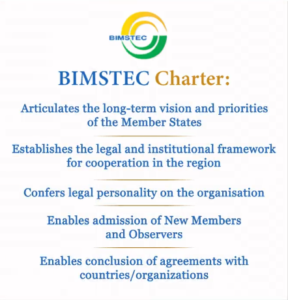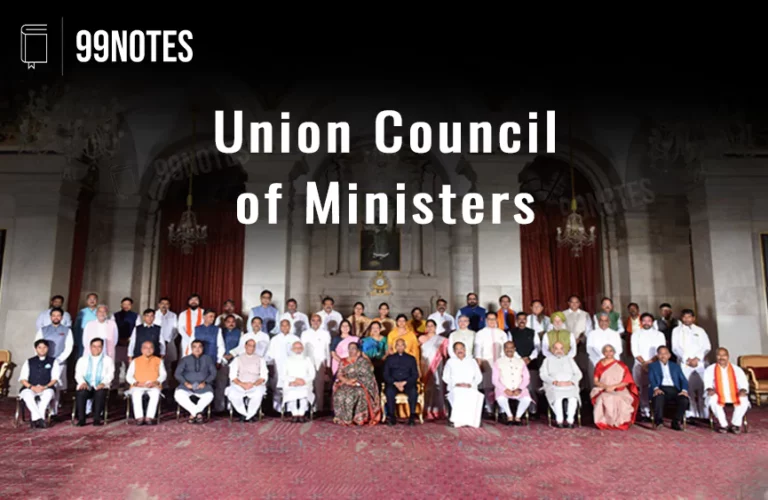BIMSTEC
The Bay of Bengal Initiative for Multi-Sectoral Technical and Economic Cooperation (BIMSTEC) is a regional organization that was established on 06 June 1997 with the signing of the Bangkok Declaration.
It was initially proposed by Thailand and was created in 1997 as BIST-EC (Bangladesh-India-Sri Lanka-Thailand Economic Cooperation). Later, the organisation came to be now known as BIMSTEC when Myanmar joined in 2004. It currently comprises seven Member States.
The BIMSTEC Permanent Secretariat at Dhaka was opened in 2014 and India contributes 32% of its expenditure.
BIMSTEC Charter:

BIMSTEC charter is a document that outlines the objectives and framework for the Bay of Bengal Initiative for Multi-Sectoral Technical and Economic Cooperation (BIMSTEC).
Its seven members signed the BIMSTEC charter on 30 March 2022 at the 5th BIMSTEC summit held virtually in Colombo, Sri Lanka. Finally, it entered into force on 20 May 2024 with the ratification by all the members.
The document gives the organisation a legal personality, establishes a mechanism for admitting new members and observers, and enables negotiations and agreements with countries and other regional and international groupings.
Structure of the Organisation:
BIMSTEC is a five-tiered organization as follows:
- The Summit comprises the Heads of State or Government of the Member States.
Function: It is the highest decision-making body in BIMSTEC. The summit sets the strategic direction and priorities for the organization. It is convened every few years to review progress and provide guidance on future actions.
- The Ministerial Meeting comprises the Ministers dealing with foreign relations of the Member States.
Function: This body is responsible for overseeing and guiding the activities of BIMSTEC in line with the decisions made at the Summit. It typically meets annually to review progress, discuss policy issues, and coordinate the organization’s programs.
- The Sectoral Ministerial Meetings comprising the Ministers of line ministries responsible for carrying out the activities of the respective sectors identified by BIMSTEC as priority areas for regional collaboration. Sectoral Ministerial Meetings provide recommendations and policy decisions that feed into the higher-level Ministerial Meetings and Summits.
- The Senior Officials’ Meeting consisting of the Foreign Secretaries/ Secretaries/ appropriate Senior officials nominated by the BIMSTEC Member States
- The BIMSTEC Permanent Working Committee (BPWC) comprises senior officials of the respective National Focal Points.
Areas of cooperation:
As the name suggests BIMSTEC is an organisation for promoting multi-sectoral technological and economic cooperation. It has identified 14 priority areas where a member country takes the lead. India is the lead country for Transport & Communication, Tourism, Environment & Disaster Management and Counter-Terrorism & Transnational Crime.
Importance of BIMSTEC:
- The BIMSTEC region has a population of roughly 22 % of the global population with a combined GDP of over US$2.7 trillion.
- Regional integration: It acts as a link between South Asia and Southeast Asia. It is the confluence of the Act East and Neighbourhood policy. This bridging role is vital for regional cooperation, connectivity, and integration. For example, the proposed BIMSTEC Free Trade Agreement will increase regional integration. While India uses BIMSTEC to reach out to Southeast Asia, Thailand and Myanmar leverage the platform to deepen ties with South Asia.
- Countering SAARC limitation: The importance of the BIMSTEC has increased as it fills the vacuum created after the cancellation of the SAARC summit in 2016, following the Uri terror attack in India. It prompted India and other member nations to shift their focus toward BIMSTEC as a more functional and cooperative regional platform.
- Security: BIMSTEC is an important platform to promote India’s Blue Economy and Maritime security. It can help in harnessing maritime resources, and promote coastal tourism.
- Economic Cooperation: Cooperation in BIMSTEC can help the economic growth of eastern coastal states, North-eastern regions etc.
- Infrastructure development: Various connectivity projects like the IMT Trilateral Highway can lead to better regional cooperation through transport connectivity.
Challenges with the BIMSTEC
BIMSTEC faces various challenges as follows:
- A slowdown in the economies: Various member countries have been facing economic issues that affect the future prospects of the BIMSTEC. For example, Nepal’s economy has entered a period of recession. Sri Lanka is slowly recovering from its worst economic and humanitarian crisis since independence. These issues cause serious implications for the regional integration.
- Lack of trust: Various issues between countries have also affected the trust between countries. For example,the Rohingya issue has continued to create complications in Bangladesh-Myanmar ties.
- Lack of Political Will: Only 5 summit-level talks have taken place between BIMSTEC countries. Thus, there is a lack of continuous engagement between countries that reflects is lack of political will.
- Issues in institutional structure: There are various institutional issues that affect the working of the organisation like delays in decision-making, non-binding agreements, financial constraints etc.
- Poor intra-regional connectivity: Physical connectivity is one of the factors that promote intra-regional integration. However, BIMSTEC faces constraints due to a lack of road and rail connectivity, insufficient last-mile connectivity etc.
Way Forward
- Addressing Bilateral Issues: India can enhance diplomatic efforts to build trust and resolve bilateral issues, especially with Myanmar and Bangladesh, to foster a more cooperative environment within BIMSTEC.
- Improving trade among the member nations: Take various measures for trade facilitations like simplifying customs procedures, and enhancing border infrastructure for trade facilitation. Various steps can also be taken like negotiation of comprehensive trade agreements like reducing tariffs and eliminating non-tariff barriers among BIMSTEC countries.
- Infrastructure Projects: There is a need to invest in infrastructure projects like the India-Myanmar-Thailand Trilateral Highway so that it can be expedited. There is a need to invest in the Rail, Road and Inland waterways so that multimodal connectivity projects can ensure last-mile connectivity.
- Further, there is a need to establish robust monitoring and evaluation mechanisms to track the progress of BIMSTEC projects and initiatives thereby improving the timely implementation of the projects.
- Resolve institutional issues of institution: Allocate financial and human resources to the BIMSTEC Secretariat.







